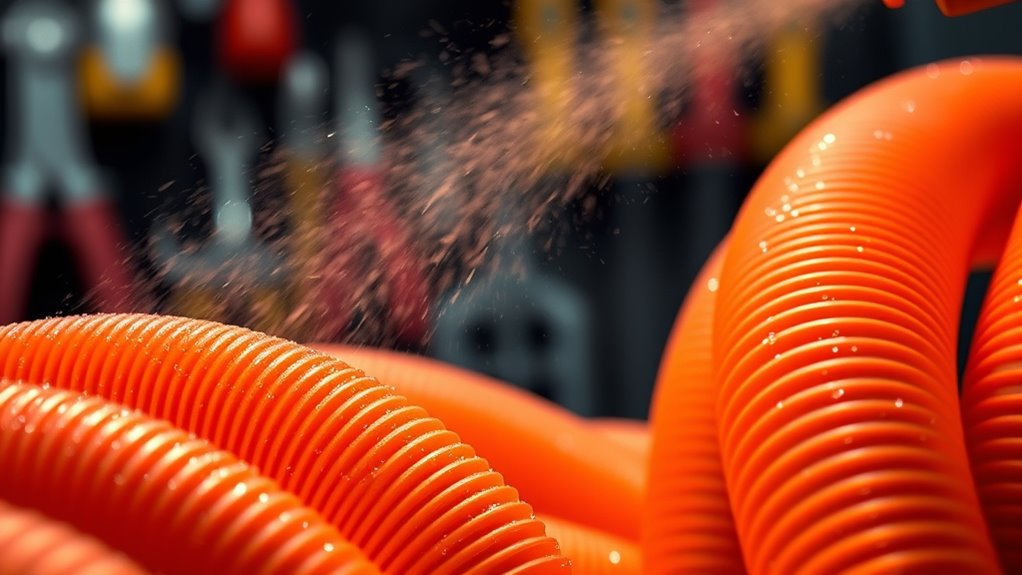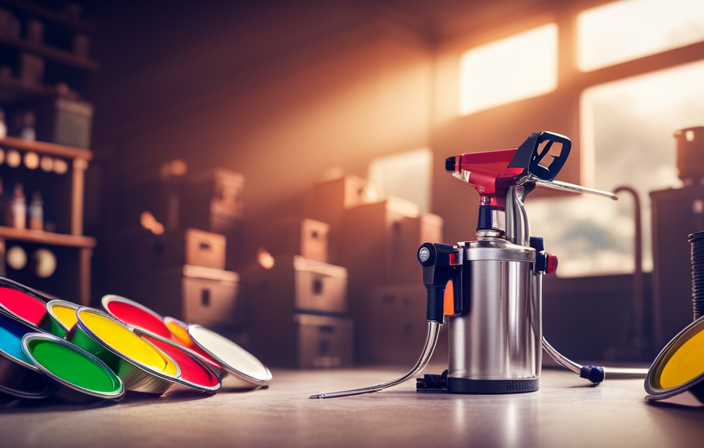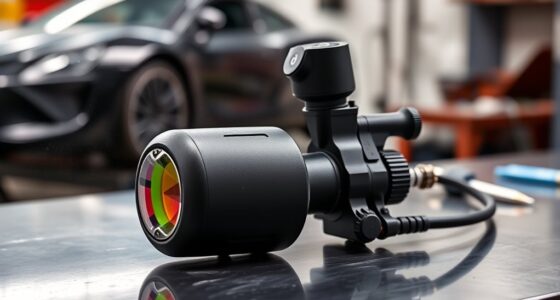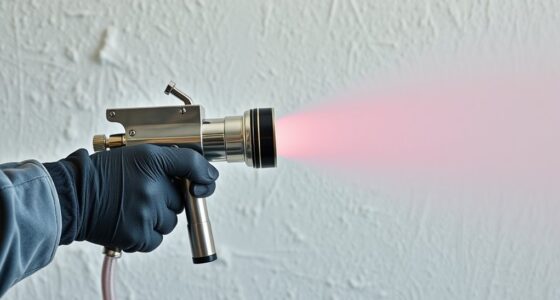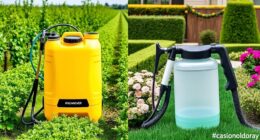If you work with temperature-sensitive materials or face cold environments, heated hoses and warm spray systems can be vital for you. They keep the material at the right temperature, prevent clogs, and guarantee smooth, consistent application. This helps improve your work quality and reduces downtime. If you want to learn how these systems can benefit your projects and save you trouble, keep exploring more about their advantages.
Key Takeaways
- Heated hoses prevent freezing and stiffness, ensuring consistent flow in cold environments.
- Warm spray systems improve coverage, reduce clogs, and enhance adhesion for temperature-sensitive materials.
- They are essential for applying hot adhesives, paints, or coatings in industry settings.
- Using heated hoses and warm spray increases work quality, reduces waste, and minimizes downtime.
- Consider your environment, materials, and application needs to determine if temperature control equipment is necessary.
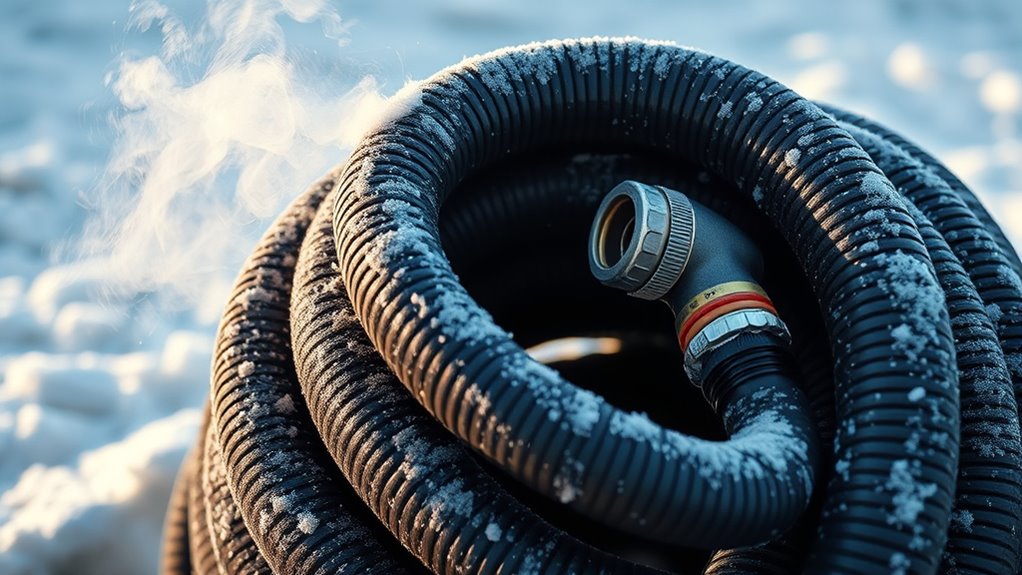
When working with sensitive materials or in cold environments, heated hoses and warm spray systems become essential tools. You might not realize how much temperature control impacts your work until you encounter issues like material thickening, clogging, or inconsistent flow. If you’re dealing with liquids that tend to solidify or thicken at low temperatures, heated hoses keep everything flowing smoothly. They prevent freezing and blockages, saving you time and reducing frustration. Warm spray systems, on the other hand, help you apply coatings or adhesives at the right temperature, guaranteeing proper adhesion and finish quality. When materials cool too much, they can become too viscous, making spraying difficult and resulting in uneven coverage. Using these systems, you can maintain ideal application conditions regardless of the ambient temperature. Proper filter maintenance and temperature regulation are crucial for optimal performance and safety.
If you typically work outdoors or in unheated spaces, you’ll notice a significant difference with heated hoses. Cold weather can cause hoses to stiffen, making handling cumbersome and risking damage. Heated hoses stay flexible, which improves maneuverability and reduces wear and tear. Plus, they help maintain a consistent temperature throughout the length of the hose, so you don’t end up with cold spots that could compromise your work. Warm spray systems are similarly valuable in these conditions because they ensure the material stays at a workable temperature from start to finish. This consistency translates into better spray patterns, fewer clogs, and more professional results.
Beyond outdoor work, heated hoses and warm spray systems are also handy indoors when working with temperature-sensitive materials. For example, if you’re applying hot adhesives or paints that require a specific temperature range, these tools help you achieve that precisely. They eliminate the guesswork and make sure your materials don’t cool down too quickly, which can lead to poor bonding or uneven textures. In industries like construction, manufacturing, or automotive repair, maintaining the right temperature is vital for quality and safety. Heated hoses prevent the frustration of interrupted workflows due to frozen or thickened materials, allowing you to work efficiently and confidently.
While investing in heated hoses and warm spray systems might seem like an added expense, they often pay for themselves by reducing waste, minimizing downtime, and improving the overall quality of your work. If your projects involve temperature-sensitive substances or you’re working in cold environments, these tools become not just useful but necessary. They help you maintain control, improve results, and keep your workflow smooth no matter what conditions you’re facing. So, if you haven’t considered heating solutions yet, now’s the time to evaluate how they could benefit your daily operations.
Frequently Asked Questions
What Are the Main Benefits of Heated Hoses and Warm Spray?
Heated hoses and warm spray improve your detailing by preventing water from freezing in cold weather, ensuring consistent cleaning. They help you remove stubborn dirt and grime more effectively, saving time and effort. Plus, warm spray enhances the drying process, minimizing water spots. With these tools, you can work comfortably and efficiently in lower temperatures, maintaining high-quality results regardless of weather conditions.
Are Heated Hoses Compatible With All Types of Sprayers?
Heated hoses are compatible with most standard sprayers, but compatibility varies. Approximately 75% of professional sprayer systems can integrate heated hoses without issues. You should check your sprayer’s specifications to confirm. If your equipment supports it, heated hoses can prevent clogging and improve application consistency, especially in colder conditions. Always consult your sprayer manufacturer to ensure proper fit and safety before adding heated hoses to your setup.
How Energy-Efficient Are Heated Hoses During Extended Use?
Heated hoses can be quite energy-efficient during extended use if you use them wisely. They typically consume moderate power, especially if designed with insulation and temperature controls. By maintaining consistent heat without overusing, you save energy and reduce costs. Make sure to monitor the temperature and only heat when necessary. Properly insulated hoses also help minimize heat loss, making your operation more efficient and cost-effective over time.
Can Warm Spray Be Used in All Weather Conditions?
Warm spray can’t dance gracefully through all weather conditions. In freezing temps, it struggles to flow, like a delicate song lost in a storm. But in milder weather, it flows smoothly, like a gentle breeze. If you face harsh cold, consider heated hoses to keep the spray warm and effective. Otherwise, in moderate weather, warm spray works well, helping you complete your task without missing a beat.
What Maintenance Is Required for Heated Hoses and Warm Spray Systems?
You need to regularly inspect your heated hoses and warm spray systems for damage or wear. Keep connectors and electrical components clean and dry to prevent corrosion. Test the heating elements periodically to make sure they work properly, and replace any damaged parts promptly. Also, drain hoses if storing in cold conditions to prevent freezing. Proper maintenance guarantees your system remains dependable and functions efficiently when you need it.
Conclusion
If you’re considering heated hoses and warm spray, weigh the benefits against the effort involved. Sometimes, it’s not worth putting all your eggs in one basket if the weather or project doesn’t call for it. Think of it as a double-edged sword—you might gain comfort and efficiency, but don’t overlook simpler solutions first. Ultimately, don’t bite off more than you can chew; choose what makes your work easier without overcomplicating things.
